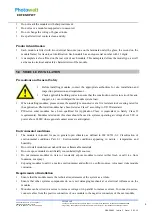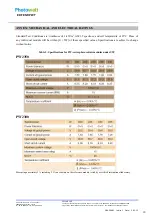
EDF ENR PWT
D06
‐
P06
‐
01
Indice
1
Date:
3
‐
01
‐
13
EDF
ENR
PWT
Société
par
actions
simplifiée
à
associé
unique
–
au
capital
de
37
505
000
€
‐
N°
513
281
972
RCS
NANTERRE
Siège
social
:
100
Esplanade
du
Général
de
Gaulle
–
Cœur
Défense
–
Tour
B
92932
Paris
La
Défense
cedex
.
33,
Rue
Saint
Honoré
‐
Z.I.
Champfleuri
38300
Bourgoin
Jallieu
‐
France
Tel
:
04
74
93
80
20
‐
Fax
:
04
74
93
80
40
Use a torque wrench for installation. The above figure shows methods of fastening module to support
structure. Tightening torques should respectively be within 4~6 Nm and 10~17 Nm for M6x1 (Example A)
and M8x1.5 (Example B) coarse thread bolts, depending on bolt class. Different recommendations from
specific clamping hardware suppliers should prevail.
Photowatt modules can be installed in either landscape or portrait position, refer to the detailed instructions
in table 2 for further guidance. Note that further countermeasures such as the use of additional support bars
should be considered in heavy snow areas (> 2400 Pa), to avoid damage by the snow accumulating in the
lowest row of modules.
Method A: Bolting
Modules should be bolted to support structures through mounting holes located in the frame's back flanges
only. Do not drill additional holes or modify the module frame. Doing so will void the warranty.
Each module must be securely fastened at a minimum of 4 points on two opposite sides. If additional wind
loads are anticipated for this installation, additional mounting points should be used. System designer and
installer are responsible for load calculation and for proper support structure design.
Modules should be bolted at the following hole locations depending on the configuration and load:
Table 2: Authorized attachments for bolting/clamping method
Bolting/clamping on short side frame
Bolting/clamping on long side frame
Uplift load
≤
2400 Pa
Downforce load
≤
5400 Pa
Use 4 standard mounting holes (short side)
Use 4 standard mounting holes (long side)
Method B: Clamping
Top or bottom clamping methods will vary depending on mounting structures. Follow mounting guidelines
recommended by the mounting system supplier.
The clamps should be positioned according to table 2, using the mounting holes as reference locators then
install and tighten the module clamps to the torque stated by the mounting hardware manufacturer.
EDF ENR PWT’s limited warranty will be void in cases where improper clamps or installation methods
deviating from this manual are used. When installing inter-modules or end type clamps, take measures so
as:
1.
Not to bend the module frame
2.
Not to touch or cast shadow on the front glass
3.
Not to damage the surface of the frame
4.
To ensure the clamps overlap the module frame by at least 9 mm
8




























